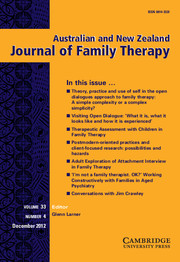Crossref Citations
This article has been cited by the following publications. This list is generated based on data provided by
Crossref.
Pitt, Tim
Lindsay, Pete
Thomas, Owen
Bawden, Mark
Goodwill, Simon
and
Hanton, Sheldon
2015.
A perspective on consultancy teams and technology in applied sport psychology.
Psychology of Sport and Exercise,
Vol. 16,
Issue. ,
p.
36.
Bloom, Kathleen
and
Tam, Jane A.
2015.
Walk-in Services for Child and Family Mental Health.
Journal of Systemic Therapies,
Vol. 34,
Issue. 1,
p.
61.
Ewen, Victoria
Mushquash, Aislin R
Bailey, Kathleen
Haggarty, John M
Dama, Sumeet
and
Mushquash, Christopher J
2016.
Same-Day Counseling: Study Protocol for the Evaluation of a New Mental Health Service.
JMIR Research Protocols,
Vol. 5,
Issue. 1,
p.
e22.
Cait, Cheryl-Anne
Skop, Michelle
Booton, Jocelyn
Stalker, Carol A
Horton, Susan
and
Riemer, Manuel
2017.
Practice-based qualitative research: Participant experiences of walk-in counselling and traditional counselling.
Qualitative Social Work,
Vol. 16,
Issue. 5,
p.
612.
Ryan, Christian
and
O’Connor, Shona
2017.
Single Session Psychology Clinic for Parents of Children with Autism Spectrum Disorder: A Feasibility Study.
Journal of Child and Family Studies,
Vol. 26,
Issue. 6,
p.
1614.
Matthews, Kristin M.
2018.
The Integration of Emotion-Focused Therapy within Single-Session Therapy.
Journal of Systemic Therapies,
Vol. 37,
Issue. 4,
p.
15.
Hass-Cohen, Noah
Bokoch, Rebecca
Clyde Findlay, Joanna
and
Banford Witting, Alyssa
2018.
A four-drawing art therapy trauma and resiliency protocol study.
The Arts in Psychotherapy,
Vol. 61,
Issue. ,
p.
44.
Ewen, Victoria
Mushquash, Aislin R.
Mushquash, Christopher J.
Bailey, S. Kathleen
Haggarty, John M.
and
Stones, Michael J.
2018.
Single-session therapy in outpatient mental health services: Examining the effect on mental health symptoms and functioning.
Social Work in Mental Health,
Vol. 16,
Issue. 5,
p.
573.
Slive, Arnold
and
Bobele, Monte
2019.
Ideas for Addressing Doubts About Walk-In/Single-Session Therapy.
Journal of Systemic Therapies,
Vol. 38,
Issue. 4,
p.
17.
Hoyt, Michael F.
Young, Jeff
and
Rycroft, Pam
2020.
Single Session Thinking 2020.
Australian and New Zealand Journal of Family Therapy,
Vol. 41,
Issue. 3,
p.
218.
Kachor, Maureen
and
Brothwell, Joanne
2020.
Improving Youth Mental Health Services Access Using a Single-Session Therapy Approach.
Journal of Systemic Therapies,
Vol. 39,
Issue. 3,
p.
46.
Courtnage, Alesya
2020.
Hoping for Change: The Role of Hope in Single-Session Therapy.
Journal of Systemic Therapies,
Vol. 39,
Issue. 1,
p.
49.
Pitt, Tim
Thomas, Owen
Lindsay, Pete
Hanton, Sheldon
and
Bawden, Mark
2020.
A Framework of Single-Session Problem-Solving in Elite Sport: A Longitudinal, Multi-Study Investigation.
Frontiers in Psychology,
Vol. 11,
Issue. ,
Lee, Eunjung
and
Tratner, Marley
2021.
Make every session count for clients! Rethinking clinical social work practice from Single Session Therapy (SST): A case illustration of Emotion-Focused Therapy (EFT).
Journal of Social Work Practice,
Vol. 35,
Issue. 4,
p.
447.
Yip, Paul Siu Fai
Chan, Wai-Leung
Chan, Christian S.
He, Lihong
Xu, Yucan
Chan, Evangeline
Chau, Yui Chi
Cheng, Qijin
Cheng, Siu-Hung
Cheung, Florence
Chow, James
Chow, Shirley
Fung, Jerry
Hsu, Siu-Man
Law, Yik Wa
Lo, Billie
Miu, Sze-Man
Ng, Wai Man
Ngai, Ken
Tsang, Christy
Xiong, Cynthia
and
Xu, Zhongzhi
2021.
The Opportunities and Challenges of the First Three Years of Open Up, an Online Text-Based Counselling Service for Youth and Young Adults.
International Journal of Environmental Research and Public Health,
Vol. 18,
Issue. 24,
p.
13194.
MacKenzie, Laura
Bedggood, Joanna
and
Csiernik, Rick
2021.
The Impact of Weather on a Canadian Post-Secondary Walk-In Counseling Program.
Journal of College Student Psychotherapy,
Vol. 35,
Issue. 3,
p.
258.
Wilson, Rebecca
and
Winnard, Yvette
2022.
Causes, impacts and possible mitigation of non-attendance of appointments within the National Health Service: a literature review.
Journal of Health Organization and Management,
Vol. 36,
Issue. 7,
p.
892.
Cannistrà, Flavio
2022.
The Single Session Therapy Mindset.
International Journal of Brief Therapy and Family Science,
Vol. 12,
Issue. 1,
p.
1.
Bobele, Monte
and
Payne, Daisy
2022.
Once Upon a Walk-In (Érase Una Vez Sin Cita).
Journal of Systemic Therapies,
Vol. 41,
Issue. 1,
p.
1.
Mulligan, Janice
Olivieri, Heather
Young, Katarina
Lin, Jia
and
Anthony, Samantha J.
2022.
Single session therapy in pediatric healthcare: the value of adopting a strengths-based approach for families living with neurological disorders.
Child and Adolescent Psychiatry and Mental Health,
Vol. 16,
Issue. 1,


